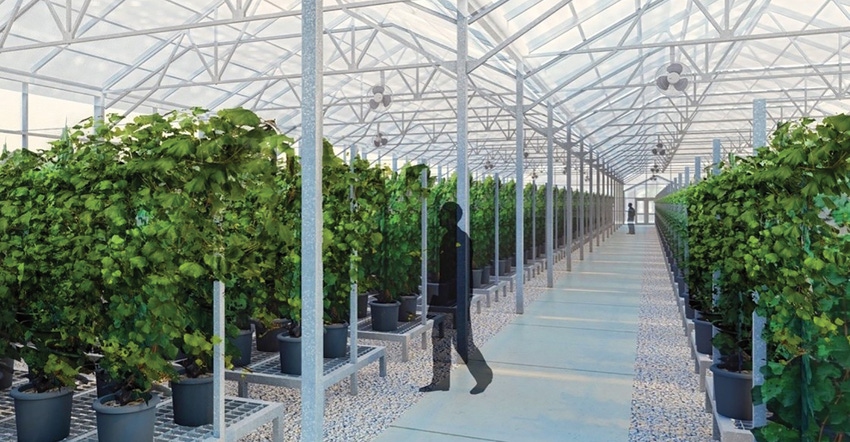
To serve and protect is generally associated with the U.S. Marine Corps, but it also applies to Foundation Plant Services on the University of California, Davis, campus.
It is there that FPS serves as the primary source for grapevine plant material distributed to nurseries under the California Department of Food and Agriculture’s Grapevine Certification Program that supplies the majority of grapevines planted in the U.S.
For the grape industry, it’s essential to protect this material from disease-carrying insects while guaranteeing fast access to clean plant material. Hence the exciting announcement that a new, 14,400-square-foot, $5.25 million greenhouse is being built there to safeguard an important grapevine collection from pathogens like red blotch disease.
“Our program is considered the largest quarantine center in the U.S. for the grapevine industry, so this is a game changer for us,” said FPS director Maher Al Rwahnih. “And this is just an insufficient starting phase for our needs as plans are already drawn up to build another greenhouse in two-to-three years that will increase capacity of the foundation’s 4,000 available vines.”
FPS has maintained healthy grapevine planting stock on campus for 70 years via open fields in two vineyards. Unfortunately, the red blotch virus was discovered at the Russell Ranch location in 2017 with more than 50% of the crop there now infected. Vineyard materials from that location are no longer being sold and the site is now part of an epidemiological study to pinpoint how that disease is transmitted.
“We think the occurrences at the ranch are location-based, but it’s caused a lot of issues,” he adds, noting that red blotch has been detected on less than one percent of the second Classic vineyard crop. “We don’t know how long the Classic vineyard will remain clean. It’s what keeps me up at night,” he said.
Once the insect-proof greenhouse is completed and operational by year-end 2023, grapevines propagated at the Classic vineyard will be tested and verified as disease-free before being moved into the new facility.
Continuous inspections
That testing is already ongoing. “We do continuous inspections to make sure the vines are free of disease and we’ve already started the process of propagating the materials in a transitional location before they get placed in the greenhouse.
“We’ll be starting with fresh, clean rootstock in the new greenhouse that will feature a vestibule entry and be insect-proof to provide another level of disease protection.”
Asked if he felt the new greenhouse could keep red blotch on the outside of the facility, the head plant pathologist replied: “Absolutely, because of how we’re putting our plants under insect control along with our rigorous spraying program. We’re starting with materials that have been thoroughly tested, with regular maintenance testing, and we’ll continue to keep our eyes open, so if anything happens we’ll know immediately and can react quickly. Our controlled insect-proofing efforts won’t present any vectors for insects to enter the new greenhouse.”
Reminded that the FPS story was somewhat like the Phoenix-rising-from-the-ashes story, he said: “Something like that. It allows us a new start, a brand new way of keeping greenhouse plants as Foundation Plant Service quality plants, the model for grapevine plant materials sold to nurseries that then grow additional plants to sell to growers.”
About the Author(s)
You May Also Like




